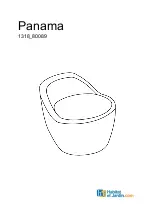
730372.doc 3429
3
Installation
Mounting the Spotlight
1. Select a horizontal , smooth surface to mount the spot/flood light on. Be sure you will have
access to the underside of the chosen location, and that you will be able to drill holes there
without damaging existing wiring or structures. Avoid locations where lines, anchors, sails or
other hazards might cause damage to the light.
NOTE:
Mounting the light as far forward or as high as possible can help to reduce reflected glare
from the deck when the light is in use.
2. Remove the large foam gasket from the box and use it as a template for the footprint of the
light.
Note:
Front mounting holes are further apart than rear mounting holes. Mark the location
of the four corner holes and the center hole squarely onto the mounting surface with pencil.
3. Drill four 5/16" (8mm) holes and one ½” in the center through the mounting surface at the
marked points.
NOTE:
Always wear eye protection when using power tools.
4. Install the foam gasket on to the base of the spot/flood light, making sure that all eight wires exit
through the center hole in the gasket.
5. Feed the eight wires coming out of the base of the light through the center hole in the mounting
surface. A
small
amount of a
non
-silicone sealant, (such as StarBrite
Boat Caulk #83801),
can be applied to where the bolts and the wires penetrate the mounting surface.
CAUTION!
Silicone based sealants may cause damage to the foam gasket or to the base of the light.
6. It is recommended that you use marine grade plywood as a back-plate.
7. Place the light on the mounting surface, lens facing forward, and align the 4 holes in the light
base and the foam gasket with the 4 corner holes drilled into the mounting surface.
8. Fasten the spot/flood light securely to the mounting surface using four 1/4" (6mm) bolts, flat
washers, lock washers and nuts (not included). Do not over tighten. Large flat fender washers
are recommended.
9. Install the gray control cable between the light and the planned location of the control panel.
Avoid running the cable across sharp edges or where it may be exposed to extreme heat.


























